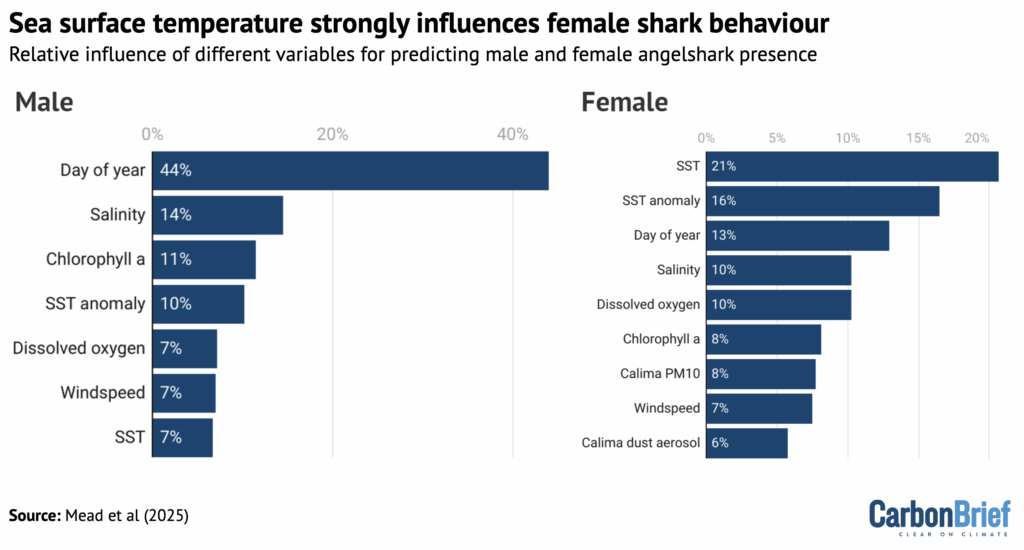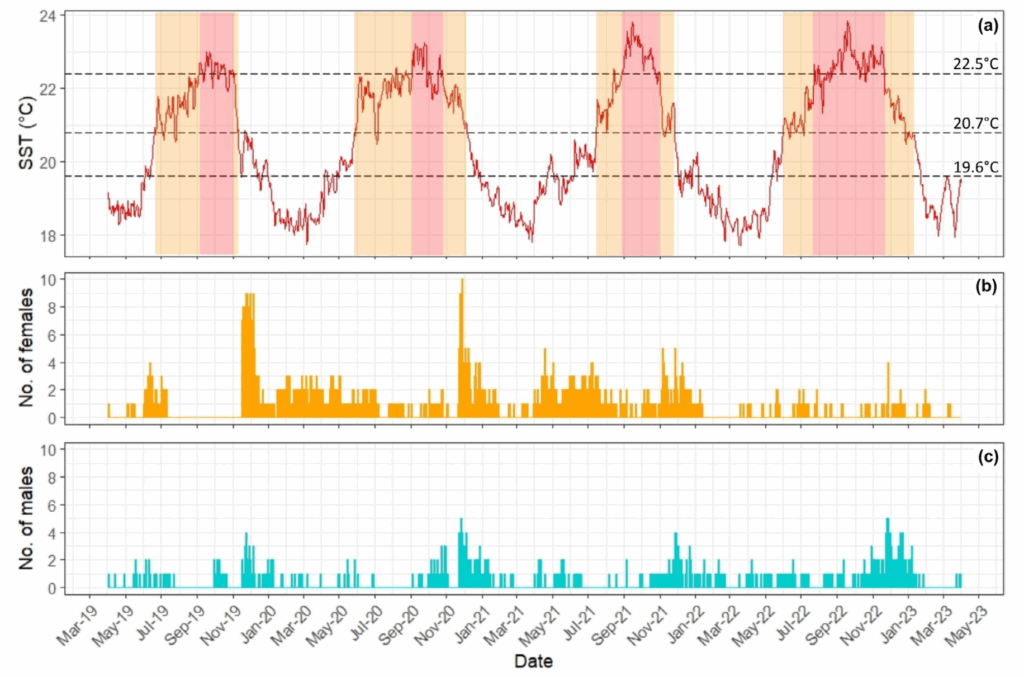“Unprecedented” ocean warming could make key habitats “inhospitable” for critically endangered angelsharks, according to new research.
The study, published in Global Change Biology, finds an “abnormal absence” of female sharks in a marine reserve near the Canary Islands throughout the 2022 breeding season.
This occurred during “unusually high” sea surface temperatures across the north-east Atlantic Ocean.
The study notes that the number of days with sea surface temperatures above 22.5C in the reserve nearly tripled over 2018-23.
This is significant, the authors say, because 22.5C is a “possible upper thermal threshold” for female angelsharks to tolerate.
The authors warn that ocean warming has “already altered” angelshark breeding behaviour, adding that the findings show that the species is “more acutely vulnerable” to climate change than previously thought.
Ocean warming
Angelsharks are flat-bodied, ray-like predators that can grow up to 2.4 metres in length.
They are typically found submerged in sandy habitats in the coastal waters of the north-east Atlantic Ocean and Mediterranean Sea.
They are listed as critically endangered on the International Union for Conservation of Nature’s (IUCN) red list of threatened species.
The authors note that the angelshark population has “declined substantially” due to “overexploitation” and “coastal habitat degradation”.
In the study, the researchers focus on the La Gaciosa Marine Reserve in the Canary Islands – Spain’s largest marine reserve.
The study notes that the Canary Islands are an “especially important region” for the angelshark and are at the “southernmost” boundary of the species’ distribution. As a result, angelshark populations around the islands have a “possibly lower tolerance for environmental change”, it states.
The researchers add that the north-east Atlantic Ocean is “undergoing rapid warming, characterised by exceptionally high temperatures and record-breaking marine heatwaves”.
As the climate continues to warm, extreme conditions are expected to occur more frequently and for longer, causing disruption to marine life.
The map below shows the historic and existing range of angelshark populations, as well as the locations of the acoustic receivers used to detect angelsharks in the study area.
To explore how climate change in the region is impacting the angelsharks, the researchers focus on “range shift”.
Range shift is when a species migrates to either remain in ideal conditions or avoid sub-optimal environments, according to what they can withstand as the climate changes.
It is one of the most “pervasive” consequences of ocean warming, the study authors say.
Tracking angelsharks
To track the movements of angelsharks, the researchers tagged the fins of 112 animals – 38 males and 74 females – over 2018-22.
These “acoustic tags” emit sound that enabled the researchers to remotely track angelshark locations.
The researchers then used this acoustic data to investigate seasonal and annual changes to angelshark presence at the study site, taking into account the contrast between male and female behaviours.
The researchers also modelled changes to the environment over 2021-23 using a range of variables. These included sea surface temperature (SST), salinity, surface wind speed and SST anomaly – a measure of how temperatures differ from the long-term average.
They also looked at concentrations of chlorophyll a and dissolved oxygen, as well as two variables that act as an indicator for levels of desert dust in the air.
The latter were used to incorporate into their model the effect of Calima events – hot and dusty winds that reach the Canary Islands from the Sahara Desert, which raise overall air temperatures.
This “environmental model” allowed the authors to investigate the relationship between angelshark presence within the reserve and changing environmental conditions.
‘Marked absence’
Previous research has linked seasonal angelshark behaviours – such as movement and presence in a certain habitat – to the breeding cycle and, sometimes, environmental factors.
The new study finds that angelshark presence in the study area varies seasonally for both sexes, peaking in November and December. It notes an additional peak in June for female angelsharks, which were also more “consistently present” in the study area throughout the year than males.
Author Dr David Jacoby is a lecturer in zoology at Lancaster University. He explains to Carbon Brief:
“Females will often avoid males outside of the breeding season as mating is pretty violent and energy expensive in sharks. Females consequently are more likely to occur in shallow water [since] males [are more likely to be found] in deeper water.”
The charts below show the relative influence of different environmental variables on predicting male and female shark presence in the study area.
The chart on the left shows how the day of the year has the biggest influence on male angelshark presence, followed by salinity. The chart on the right shows that for female angelsharks, SST – followed by SST anomaly – was the most significant predictor.

The “crux” of the study, according to Jacoby, is that in 2022 – when peak SSTs were higher and those conditions lasted longer – female angelshark numbers were “consistently low”. He tells Carbon Brief:
“The fact that there was this significant warming event in the north-east Atlantic was opportunistic from a research perspective at least, because it provided a natural experiment in which to directly compare behaviour under ‘normal’ versus ‘extreme’ conditions.”
This “marked absence” was especially noticeable during the angelshark breeding season in mid-to-late autumn, the data shows. In contrast, the behaviour of the male sharks did not change.
The charts below illustrate how, in 2022, daily counts of female angelsharks (orange bars in the middle panel) dropped in the unusually warm conditions, while daily counts of male angelsharks (turquoise bars in the bottom panel) remained consistent with previous years.
In the top panel, orange regions indicate periods in which SSTs are between 20.7C and 22.5C and red regions show periods of SSTs above 22.5C.
According to the authors, the presence of female sharks in the study site decreases “rapidly” at SSTs above 20.7C, while the “probability of female presence” is below zero above around 22.5C.
The dotted line at 19.6C shows the temperature of peak female angelshark presence.

The researchers say their findings “strongly” indicate that the low numbers of females during the breeding season in 2022 were linked to the “thermal extremes” that year.
They point to an “upward trend” in peak temperatures and longer duration of hotter periods in their dataset, noting that the number of days where SSTs reached 22.5C more than doubled over the study period.
As a result, the authors identify 22.5C as the “possible upper thermal threshold” for female angelsharks – meaning that the animals will not move into an area at this point.
They warn that regular temperatures of 22.5C could “disrupt” the timing of “key biological events”, such as breeding.
The “unusual” findings, recorded as “disrupted” thermal cues, may be a “window into future climate change impacts”, suggest the authors.
Conservation measures
The authors highlight the need to prioritise further “species-specific” studies that incorporate “real-time environmental and behavioural data” and explore climate impacts by sex.
Improving scientific understanding and prediction of how marine species and ecosystems respond to climate change are “urgent priorities”, they say.
Jacoby adds:
“Angelsharks [are among] the most threatened fishes in the world. Because they rely on the ocean floor to rest and hunt, they are extremely attuned to their local environment. [Ocean warming] could lead to the [local extinction] of this species from the archipelago in a very worst case due to the fact that they are already at their thermal extreme in this location…
“We still don’t really know how warming could impact the complex web of interactions within these coastal ecosystems. It is so hard to engage with a problem if you can’t see it for yourself.”
Dr Hollie Booth is a postdoctoral researcher in the department of biology at the University of Oxford and was not involved in the study. She tells Carbon Brief that although the negative impacts of climate change are “concerning”, overfishing remains “the greatest direct threat” to angelshark populations.
She adds:
“It is good to see empirical evidence of the impacts of climate change on threatened marine species. [The study] indicates how we need to make sure that contributors to climate change are also held accountable for mitigating [these] impacts.”
Mead et al. (2025) Rapid ocean warming drives sexually divergent habitat use in a threatened predatory marine ectotherm, Global Change Biology, https://doi.org/10.1111/gcb.70331
Great Job Ushika Kidd & the Team @ Carbon Brief Source link for sharing this story.





